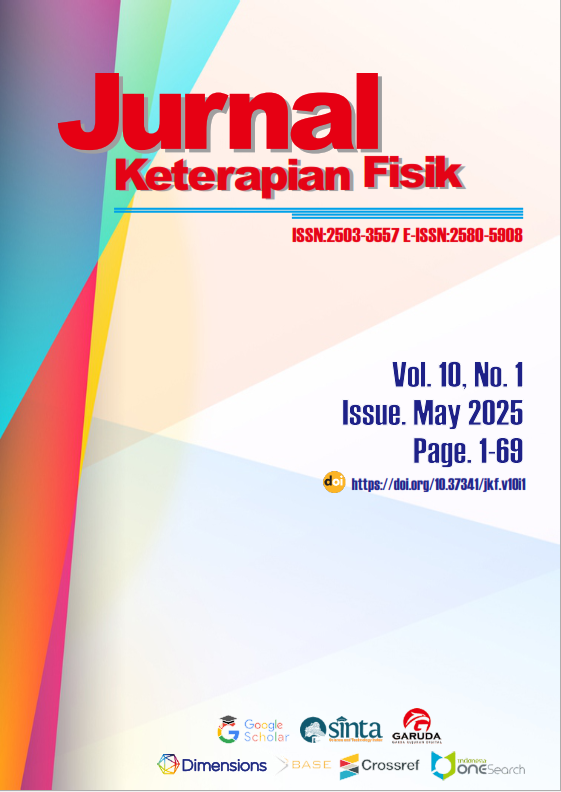Effect of Using Medial Arch Support on Foot Pain (Plantar Fasciitis) in Pregnant Women
Main Article Content
Abstract
Background: Pregnancy often causes physical and psychological discomfort, including foot pain or plantar fasciitis due to inflammation of the plantar fascia, which is worsened by increased body weight. Medial arch support is an orthotic device designed to relieve this pain by stabilizing the medial longitudinal arch of the foot. This study aims to examine the effect of using medial arch support in reducing foot pain (plantar fasciitis) in third-trimester pregnant women.
Methods: This quantitative study used a quasi-experiment with a one-group pre-test and post-test design to examine the effect of medial arch support on foot pain in pregnant women. The study was conducted in Noborejo, Salatiga. The sampling technique used is purposive sampling and involved 20 pregnant women who often complained of foot pain in the 2-3 trimesters. Pain levels were measured using the Numeric Rating Scale (NRS) before and after a two-week intervention with medial arch support.
Results: The Wilcoxon test results indicate a significant reduction in foot pain (p= <0.001, p < 0.05). The average pain score before the intervention was 7.9, which decreased to 4.5 after the use of medial arch support, reflecting a pain reduction of 43%. The average difference in pain level before and after the intervention was 3.4.
Conclusion: Medial arch support significantly reduces foot pain (plantar fasciitis) in pregnant women. This intervention offers a practical solution to reduce discomfort and improve the quality of health of pregnant women. Further studies are needed on the long-term use of medial arch support in pregnancy.
Article Details
How to Cite
References
Alcahuz-Griñan, M., Nieto-Gil, P., Perez-Soriano, P., & Gijon-Nogueron, G. (2021). Morphological and postural changes in the foot during pregnancy and puerperium: A longitudinal study. International Journal of Environmental Research and Public Health, 18(5), 2423. https://doi.org/10.3390/ijerph18052423
Barczyk-Pawelec, K., Hawrylak, A., Bińczyk, A., & Demczuk-Włodarczyk, E. (2021). Structural changes in foot and arch dimensions in the third trimester of pregnancy. Human Movement, 22(2), 87–92. https://doi.org/10.5114/hm.2021.100017
Buchanan, B. K., Sina, R. E., & Kushner, D. (2024). Plantar fasciitis. In StatPearls [Internet]. StatPearls Publishing.
Fiat, F., Merghes, P. E., Scurtu, A. D., Almajan Guta, B., Dehelean, C. A., Varan, N., & Bernad, E. (2022). The main changes in pregnancy: Therapeutic approach to musculoskeletal pain. Medicina, 58(8), 1115. https://doi.org/10.3390/medicina58081115
Khired, Z., Najmi, M. H., Akkur, A. A., Mashhour, M. A., Bakri, K. A., Najmi, M., Mashhour, M., & Bakri, K. (2022). The prevalence and risk factors of plantar fasciitis amongst the population of Jazan. Cureus, 14(9). https://doi/10.7759/cureus.29434
Lerebourg, L., L’Hermette, M., Menez, C., & Coquart, J. (2020). The effects of shoe type on lower limb venous status during gait or exercise: A systematic review. PLoS One, 15(11), 1-19. https://doi.org/10.1371/journal.pone.0239787
Masłoń, A., Suder, A., Curyło, M., Frączek, B., Salamaga, M., Ivanenko, Y., & Forczek-Karkosz, W. (2022). Influence of pregnancy related anthropometric changes on plantar pressure distribution during gait: A follow-up study. Plos One, 17(3), 1-12. https://doi.org/10.1371/journal.pone.0264939
Pascual, Z. N., & Langaker, M. D. (2023). Physiology, pregnancy. In StatPearls [Internet]. StatPearls Publishing.
Peng, Y., Wang, Y., Wong, D. W.-C., Chen, T. L.-W., Chen, S. F., Zhang, G., Tan, Q., & Zhang, M. (2022). Different design feature combinations of flatfoot orthosis on plantar fascia strain and plantar pressure: A muscle-driven finite element analysis with taguchi method. Frontiers in Bioengineering and Biotechnology, 10, 1-9. https://doi.org/10.3389/fbioe.2022.853085
Shmerling, R. H. (2023). Plantar fasciitis. Harvard Health Publishing. Retrieved May 20, 2025, from https://www.health.harvard.edu/a_to_z/plantar-fasciitis-a-to-z
Sutanto, R., & Sidarta, N. (2022). Indeks massa tubuh berhubungan dengan nyeri plantar fasciitis usia 20-50 tahun. Jurnal Biomedika Dan Kesehatan, 5 (1), 50-56. http://dx.doi.org/10.18051/JBiomedKes.2022.v5.50-56
Thong-On, S., & Harutaichun, P. (2023). Effects of customized insoles with medial wedges on lower extremity kinematics and ultrasonographic findings in plantar fasciitis persons. Scientific Reports, 13(1), 1-11. https://doi.org/10.1038/s41598-023-35862-6
Wulandari, S., & Wantini, N. A. (2021). Ketidaknyamanan fisik dan psikologis pada ibu hamil trimester III di Wilayah Puskesmas Berbah Sleman Daerah Istimewa Yogyakarta. Jurnal Kebidanan Indonesia, 12(1), 54-67. https://doi.org/10.36419/jki.v12i1.438
Yar, U. Bin. (2022). A review: Biomechanical substitutions during pregnancy and application of orthoses. Journal of University Medical & Dental College, 13(3), 446–452. https://doi.org/10.37723/jumdc.v13i3.715
Zangão, M. O. B., Poeira, A. F., Branco, M., & Santos-Rocha, R. (2024). Changes in foot biomechanics during pregnancy and postpartum: Scoping review. International Journal of Environmental Research and Public Health, 21(5), 1-9. https://doi.org/10.3390/ijerph21050638
Zhao, R. T., Kandil, A., Nguyen, D. V, Campos, L., Amin, N. H., & Chang, E. Y. (2020). Pain perception in taekwondo: Relationship to injury, experience, and time loss. Sports Medicine International Open, 4(02), E53–E58. https://doi.org/10.1055/a-1168-9167

